Intel Beast Canyon NUC Review: Desktop Tiger Lake Debuts in SFF Gaming Powerhouse
by Ganesh T S on July 29, 2021 9:00 AM EST- Posted in
- Systems
- Intel
- NUC
- Tiger Lake
- NUC11
- Beast Canyon
BAPCo SYSmark 25
The Intel NUC11BTMi9 (Beast Canyon) was evaluated using our Fall 2018 test suite for small-form factor PCs. In the first section, we will be looking at SYSmark 25.
BAPCo's SYSmark 25 is an application-based benchmark that uses real-world applications to replay usage patterns of business users in the areas of productivity, creativity, and responsiveness. The 'Productivity Scenario' covers office-centric activities including word processing, spreadsheet usage, financial analysis, software development, application installation, file compression, and e-mail management. The 'Creativity Scenario' represents media-centric activities such as digital photo processing, AI and ML for face recognition in photos and videos for the purpose of content creation, etc. The 'Responsiveness Scenario' evaluates the ability of the system to react in a quick manner to user inputs in areas such as application and file launches, web browsing, and multi-tasking.
Scores are meant to be compared against a reference desktop (the SYSmark 25 calibration system, a Lenovo Thinkcenter M720q with a Core i5-8500T and 8GB of DDR4 memory to go with a 256GB M.2 NVMe SSD). The calibration system scores 1000 in each of the scenarios. A score of, say, 2000, would imply that the system under test is twice as fast as the reference system.
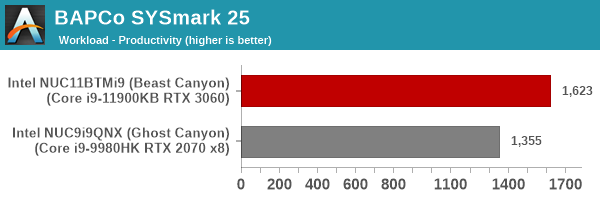
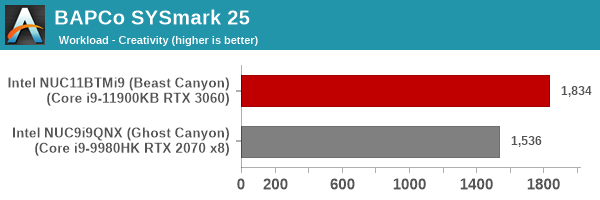
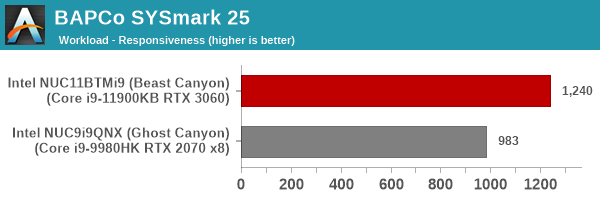
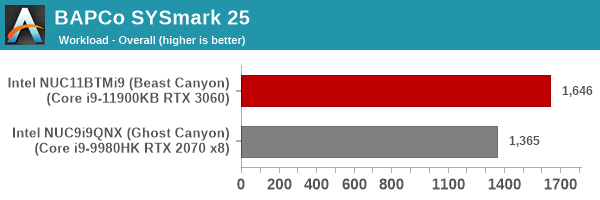
SYSmark 25 also adds energy measurement to the mix. A high score in the SYSmark benchmarks might be nice to have, but, potential customers also need to determine the balance between power consumption and the efficiency of the system. For example, in the average office scenario, it might not be worth purchasing a noisy and power-hungry PC just because it ends up with a 2000 score in the SYSmark 2014 SE benchmarks. In order to provide a balanced perspective, SYSmark 25 also allows vendors and decision makers to track the energy consumption during each workload. In the graphs below, we find the total energy consumed by the PC under test for a single iteration of each SYSmark 25 workload. For reference, the calibration system consumes 8.88 Wh for productivity, 10.81 Wh for creativity, and 19.69 Wh overall.
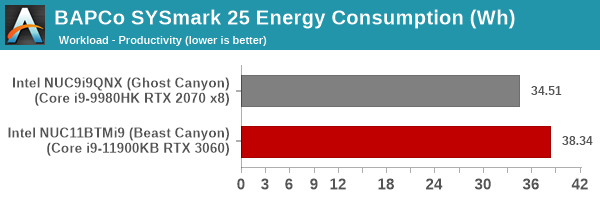
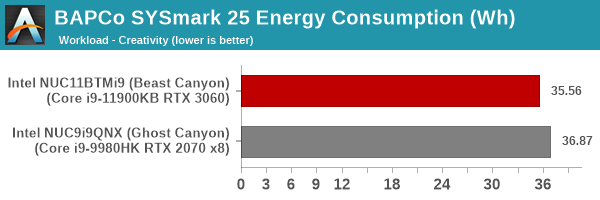
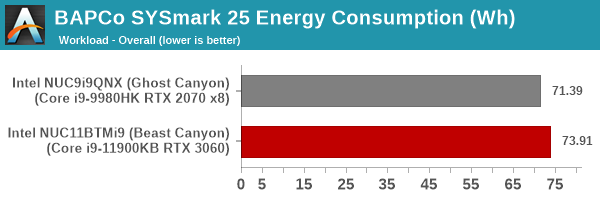
The Beast Canyon outscores the Ghost Canyon by around 20%. The increase in energy consumption is miniscule.










84 Comments
View All Comments
vol.2 - Tuesday, August 3, 2021 - link
SFF = SMALL form factorIntel's marketing literature was pretty specific about it. Sure, they can change what NUC means by turning into a generic smallish PC device similar to Micro ATX, but that genericizes the NUC to the point where it just becomes Intel's brand for a form factor that already exists.
mode_13h - Wednesday, August 4, 2021 - link
> but that genericizes the NUC to the point where it just becomes Intel's brandYes, Intel is a pro at taking a naming scheme that has some logic to it, and then twisting it into something meaningless. Like, the i3/i5/i7 naming scheme, for instance. On some of their laptop chips, like the U-series Skylakes, they had exactly the same core-count and thread-count, differing only in a few hundred MHz of clock speed.
Hey, if marketing simply came up with a logical naming scheme and sticking to it, how would they "add value"? Marketing is always looking for a way to gin up sales, in the next quarter or FY.
mode_13h - Wednesday, August 4, 2021 - link
Remember, we're talking about the same Intel that changed their Xeon processors from using the E3/E5/E7 naming scheme to E/W/Silver/Gold/Platinum, back in 2017!mode_13h - Sunday, August 1, 2021 - link
> Intel are clearly moving the goalposts here on what a NUC form factor should beSo far, the lineup is:
* NUC Essential
* NUC
* NUC Pro
* NUC Extreme
I expect further up-range models will be:
* NUC Insane - HEDT CPU + dual GPU + water cooling
* NUC Ridiculous - dual CPU + quad-GPU + external radiator
willis936 - Thursday, July 29, 2021 - link
Now make it with ECC :)Jorgp2 - Thursday, July 29, 2021 - link
Buy one with ECCwillis936 - Thursday, July 29, 2021 - link
I would if the chipsets of CPUs from anytime in the past two years were available.AdrianBc - Thursday, July 29, 2021 - link
The previous Ghost Canyon had a variant with a mobile Xeon and ECC memory.It was very nice, except for 2 problems.
It was introduced one year too late, when Coffee Lake Refresh was already too obsolete and it was overpriced by about $500 compared with a standard desktop with similar features.
For this one, no version with a Xeon has been announced and there were no rumors about such a version.
dullard - Thursday, July 29, 2021 - link
I'm curious what niche use case needs a moderately small computer, but not too small, with video card, and ECC.AdrianBc - Thursday, July 29, 2021 - link
There are people like myself, who do not accept to use a computer without ECC in any circumstance. So, except for my mobile phone, I do not use any computer without ECC, neither as a laptop, nor as a desktop nor as a SFF computer and of course not as a server.Any computer without ECC is just a toy, guaranteed to have errors from time to time, which should be used only in game consoles or similar applications.
The fact that the computers without ECC are not a small niche is sad and this just shows how many people are so gullible that they will believe whatever a vendor says that is good for them.